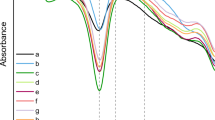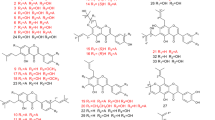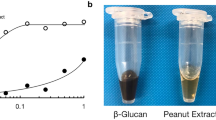Abstract
ACETYLCHOLINE is required in the diet of silkworm larvae for normal moulting to occur. On a semi-synthetic basal diet (Table 1, No. 4) the newly hatched larvae die after about 14 days without further moult. In tests each using twenty larvae, it was found that the diet containing mulberry leaves (diet 1, ref. 1) yielded 100 per cent successful moult to second instar with a larval weight of 5.4 mg each; the diet with defatted soybean2,3 and no other important adjuvants (diet 2) yielded 80 per cent moult (4.5 mg); the diet with royal jelly4 (diet 3) yielded 100 per cent moult (5.85 mg); the basal diet without adjuvants (diet 4) yielded no moult; the basal diet with royal jelly (diet 5) yielded 70 per cent moult (4.8 mg); and basal diet plus acetylcholine (diet 6) yielded 80 per cent moult (4.0 mg). From these results one observes that royal jelly increases moulting and larval weight. Royal jelly contains large amounts of acetylcholine5,6. A watersoluble, low-molecular-weight, dialysable fraction of royal jelly also provided similar growth stimulation. We therefore added acetylcholine to the diet7 expecting the same results as with royal jelly (diet 6). As described here, acetylcholine can replace royal jelly in stimulating moulting of the larvae.
This is a preview of subscription content, access via your institution
Access options
Subscribe to this journal
Receive 51 print issues and online access
$199.00 per year
only $3.90 per issue
Buy this article
- Purchase on Springer Link
- Instant access to full article PDF
Prices may be subject to local taxes which are calculated during checkout
Similar content being viewed by others
References
Fukuda, T., Suto, M., and Higuchi, Y. L., Nature, 187, 669 (1960).
Ito, T., J. Sericult. Sci. Japan (Nippon Sanshigaku Zasshi), 31, 1 (1962).
Hayashiya, K., Naito, K., Matsuura, K., Nishida, J., and Hamamura, Y., J. Agri. Soc. Japan (Nippon Nogeikagaku Zassi) in the press.
Ito, T., J. Jap. Soc. Food and Nutrition (Eiyo to Syokuryo), 14, 1 (1961).
Henscher, D., Naturwissenschaften, 6, 41 (1954).
Watanabe, T., J. Pharm. Soc. Japan (Yakugaku Zassi), 75, 86 (1955).
Hamamura, Y., Hayashiya, K., and Naito, K., Nature, 190, 879 (1961).
Gilmour, D., Biochemistry of Insects (Academic Press: New York and London, 1961).
Author information
Authors and Affiliations
Rights and permissions
About this article
Cite this article
HAYASHIYA, K., KATO, M. & HAMAMURA, Y. Acetylcholine as a Growth Factor in Early Larval Development of the Silkworm. Nature 205, 620–621 (1965). https://doi.org/10.1038/205620a0
Issue Date:
DOI: https://doi.org/10.1038/205620a0
Comments
By submitting a comment you agree to abide by our Terms and Community Guidelines. If you find something abusive or that does not comply with our terms or guidelines please flag it as inappropriate.



